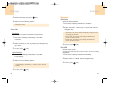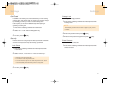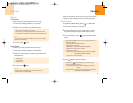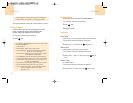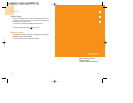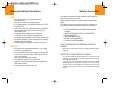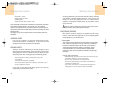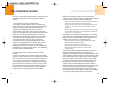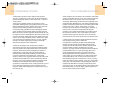
121120
Safety InformationBattery Handling Information
DOS
H Only use the battery and charger approved by
the manufacturer.
H Only use the battery for its original purpose.
H Try to keep batteries in a temperature between 41ºF (5ºC)
and 95ºF (35ºC).
H If the battery is stored in temperatures above or below the
recommended range, give it time to warm up or cool
down before using.
H Completely drain the battery before recharging.
It may take one to four days to completely drain.
H Store the discharged battery in a cool, dark, and dry place.
H Purchase a new battery when its operating time gradually
decreases after fully charging.
H Properly dispose of the battery according to local laws.
DON’TS
H Don’t attempt to disassemble the battery – it is a sealed
unit with no serviceable parts.
H Don’t accidentally short circuit the battery by carrying it in
your pocket or purse with other metallic objects such as
coins, clips and pens.
This may critically damage the battery.
H Don’t leave the battery in hot or cold temps.
Otherwise, it could significantly reduce the capacity and
lifetime of the battery.
H Don’t dispose of the battery into a fire.
This chapter addresses the safety guidelines and precautions to
follow when operating your phone.
Before operating your phone, please be aware of all the safety
details.
This chapter contains the terms and conditions of services and
the warranty for your phone. Please review them thoroughly.
H SAFETY INFORMATION FOR WIRELESS HANDHELD
PHONES
H SAFETY INFORMATION FOR FCC RF EXPOSURE
H SAR INFORMATION
H FDA CONSUMER UPDATE
H PROTECT YOUR WARRANTY
H 12 MONTH LIMITED WARRANTY
SAFETY INFORMATION FOR WIRELESS HANDHELD
PHONES
Read This Information Before Using Your Handheld Portable Cellular
Telephone.
EXPOSURE TO RADIO FREQUENCY SIGNALS
Your wireless handheld portable telephone is a low power radio
transmitter and receiver. When it is ON, it receives and also sends out
radio frequency (RF) signals.
In August 1996, the Federal Communications Commissions (FCC)
adopted RF exposure guidelines with safety levels for handheld
wireless phones. Those guidelines are consistent with the safety
standards previously set by both U.S. and international standards
bodies:





